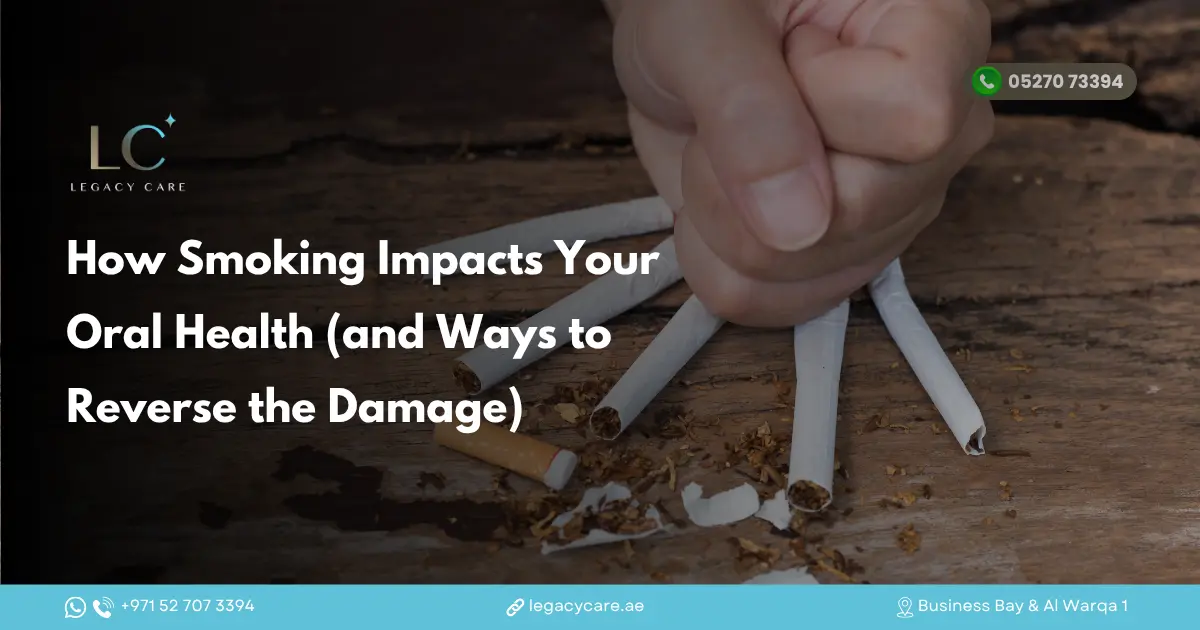If you smoke, you’ve probably heard it’s bad for your health — your lungs, your heart, your skin.
But what many people don’t realize is that smoking quietly damages your mouth too. And often, by the time you notice it, the effects have already been building for years.
At Legacy Care, we meet many patients in Dubai who come in for routine cleanings or whitening, and we spot early signs of tobacco damage. Some are surprised. Others already feel the effects — bleeding gums, bad breath, or loose teeth. The truth is, smoking doesn’t just stain your teeth; it changes the way your entire mouth heals and defends itself.
Let’s talk about how it really affects your oral health — and what you can still do to protect and repair your smile.
The Hidden Ways Smoking Hurts Your Mouth
When you smoke, every puff coats your mouth in toxins. Nicotine and tar cling to your teeth and gums, and over time, they affect your blood flow and immune response.
Your gums don’t get enough oxygen or nutrients, which makes it harder for them to heal — even from small irritations like brushing or flossing.
That’s why smokers are more likely to develop gum disease, which starts quietly with red, swollen gums and ends with loose teeth if untreated.
I’ve seen patients who brush twice a day but still struggle because their gums just can’t fight back like they should.
Gum Disease and Tooth Loss — The Silent Progression
Gum disease is one of the biggest consequences of smoking.
At first, you might notice a bit of bleeding when you brush or a faint bad taste that doesn’t go away. Then, slowly, the gums start to pull back from the teeth — this is called gum recession.
What happens next? The bone supporting your teeth starts to shrink. Teeth become wobbly, chewing feels strange, and eventually, some fall out.
The heartbreaking part is, many smokers don’t feel much pain early on because nicotine reduces blood flow — it hides the symptoms. So the damage continues quietly.
The good news? With professional gum treatment and quitting smoking, this process can often be stopped — and in some cases, even reversed.
The Cosmetic Side: Stains, Bad Breath, and Dark Gums
Let’s be honest — one of the most visible effects of smoking is staining.
Nicotine and tar leave behind deep yellow or brown marks that regular brushing can’t remove. Professional cleaning helps, but constant smoking keeps bringing the stains back.
Then there’s the breath. The combination of smoke, bacteria, and dry mouth leads to persistent bad breath that no mouthwash can fully hide.
Some patients also notice their gums turning darker — not just from pigmentation, but from reduced oxygen in the tissues. Over time, this makes smiles look dull, even unhealthy.
If you’ve been avoiding smiling in photos because of discoloration, you’re not alone. Many of our patients at Legacy Care start with whitening or scaling, but they find that the real transformation happens when they finally quit.
Oral Cancer — The Risk You Can’t Ignore
This one’s tough to talk about, but it’s important.
Smoking is one of the biggest risk factors for oral cancer. It can affect your lips, tongue, cheeks, or throat.
Early signs include white or red patches, sores that don’t heal, or persistent hoarseness.
Every year, dentists spot hundreds of early cases during routine checkups — and early detection saves lives. That’s why even if you smoke, regular dental visits are absolutely critical. It’s not just about cleaning your teeth; it’s about catching things early.
Can You Reverse the Damage?
Here’s the hopeful part — your mouth can recover, but it takes time and consistency.
Once you quit smoking, blood circulation improves within weeks. Your gums start healing better, inflammation goes down, and your breath freshens up.
Over a few months, you’ll notice fewer ulcers, better color in your gums, and even whiter teeth with professional cleaning.
Here’s what helps speed up recovery:
- Get a deep cleaning or scaling every six months.
- Rinse with an antibacterial mouthwash to fight gum bacteria.
- Stay hydrated — dry mouth worsens smoke-related damage.
- Eat vitamin-rich foods, especially those high in vitamin C and calcium.
- Book regular oral cancer screenings, especially if you’ve smoked for years.
Some patients even go for a smile makeover once they’ve quit — veneers, whitening, or gum reshaping — to bring back confidence and brightness.
How Legacy Care Can Help You Heal
At Legacy Care, we take a supportive approach. We know quitting isn’t easy — and we never judge.
Our goal is to help you manage and repair the effects of smoking while you work toward better oral health.
Our team uses advanced air polishing to remove deep stains safely, laser gum treatments to reduce infection, and gentle whitening systems that restore natural brightness without harming enamel.
We also provide personalized dental plans — whether you’re still smoking or in the process of quitting — because every mouth is different.
Even small steps, like switching to professional cleanings every 4 months instead of 6, can make a big difference in how your mouth feels and heals.
A Final Thought
Your smile says a lot about you — and it deserves a second chance.
If you’ve smoked for years, don’t feel discouraged. The damage isn’t permanent if you start caring now. I’ve seen countless patients turn things around. Once they quit and commit to regular care, their smiles — and confidence — return faster than they expected.
So take the first step today. Your future smile will thank you.
📍 Book a visit at Business Bay or Al Warqa 1
📞 Call +971 527073394
📅 Book Online: https://www.legacycare.ae/book-appointment/

